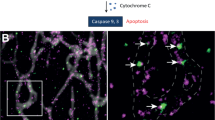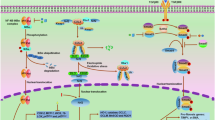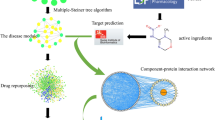Abstract
Aim:
To examine if steroid-like compounds found in many Chinese medicinal products conventionally used for the promotion of blood circulation may act as active components via the same molecular mechanism triggered by cardiac glycosides, such as ouabain.
Methods:
The inhibitory potency of ouabain and the identified steroid-like compounds on Na+/K+-ATPase activity was examined and compared. Molecular modeling was exhibited for the docking of these compounds to Na+/K+-ATPase.
Results:
All the examined steroid-like compounds displayed more or less inhibition on Na+/K+-ATPase, with bufalin (structurally almost equivalent to ouabain) exhibiting significantly higher inhibitory potency than the others. In the pentacyclic triterpenoids examined, ursolic acid and oleanolic acid were moderate inhibitors of Na+/K+-ATPase, and their inhibitory potency was comparable to that of ginsenoside Rh2. The relatively high inhibitory potency of ursolic acid or oleanolic acid was due to the formation of a hydrogen bond between its carboxyl group and the Ile322 residue in the deep cavity close to two K+ binding sites of Na+/K+-ATPase. Moreover, the drastic difference observed in the inhibitory potency of ouabain, bufalin, ginsenoside Rh2, and pentacyclic triterpenoids is ascribed mainly to the number of hydrogen bonds and partially to the strength of hydrophobic interaction between the compounds and residues around the deep cavity of Na+/K+-ATPase.
Conclusion:
Steroid-like compounds seem to contribute to therapeutic effects of many cardioactive Chinese medicinal products. Chinese herbs, such as Prunella vulgaris L, rich in ursolic acid, oleanolic acid and their glycoside derivatives may be adequate sources for cardiac therapy via effective inhibition on Na+/K+-ATPase.
Similar content being viewed by others
Log in or create a free account to read this content
Gain free access to this article, as well as selected content from this journal and more on nature.com
or
References
Gong X, Sucher NJ . Stroke therapy in traditional Chinese medicine (TCM): prospects for drug discovery and development. Trends Pharmacol Sci 1999; 20: 191–6.
Kim H . Neuroprotective herbs for stroke therapy in traditional eastern medicine. Neurol Res 2005; 27: 287–301.
Li-Saw-Hee FL, Lip GY . Digoxin revisted. QJM 1998; 91: 259–64.
Schönfeld W, Menke KH, Schönfeld R, Repke KR . 5 Beta, 14 beta-androstane-3 beta, 14-diol binds to the digitalis receptor site on Na/K-ATPase. J Enzyme Inhib 1987; 2: 37–45.
Zhou J . Bioactive glycosides from Chinese medicines. Mem Inst Oswaldo Cruz 1991; 86: 231–4.
Chen RJ, Chung TY, Li FY, Lin NH, Tzen JT . Effect of sugar positions in ginsenosides and their inhibitory potency on Na+/K+-ATPase activity. Acta Pharmacol Sin 2009; 30: 61–9.
Morth JP, Pedersen BP, Toustrup-Jensen MS, Sørensen TL, Petersen J, Andersen JP, et al. Crystal structure of the sodium-potassium pump. Nature 2007; 450: 1043–9.
Ogawa H, Shinoda T, Cornelius F, Toyoshima C . Crystal structure of the sodium-potassium pump (Na+,K+-ATPase) with bound potassium and ouabain. Proc Natl Acad Sci USA 2009; 106: 13742–7.
Brooks BR, Bruccoleri RE, Olafson BD, States DJ, Swaminathan S, Karplus M . CHARMM: A program for macromolecular energy minimization and dynamics calculations. J Comp Chem 1983; 4: 187–217.
Qiu LY, Krieger E, Schaftenaar G, Swarts HG, Willems PH, De Pont JJ, et al. Reconstruction of the complete ouabain-binding pocket of Na,K-ATPase in gastric H,K-ATPase by substitution of only seven amino acids. J Biol Chem 2005; 280: 32349–55.
Dixon SL, Merz KM Jr . One-dimensional molecular representations and similarity calculations: methodology and validation. J Med Chem 2001; 44: 3795–809.
Rao SN, Head MS, Kulkarni A, LaLonde JM . Validation studies of the site-directed docking program LibDock. J Chem Inf Model 2007; 47: 2159–71.
Yang Z, Luo H, Wang H, Hou H . Preparative isolation of bufalin and cinobufagin from Chinese traditional medicine ChanSu. J Chromatogr Sci 2008; 46: 81–5.
Jia WW, Bu X, Philips D, Yan H, Liu G, Chen X, et al. Rh2, a compound extracted from ginseng, hypersensitizes multidrug-resistant tumor cells to chemotherapy. Can J Physiol Pharmacol 2004; 82: 431–7.
Lee IK, Kim do H, Lee SY, Kim KR, Choi SU, Hong JK, et al. Triterpenoic acids of Prunella vulgaris var lilacina and their cytotoxic activities in vitro. Arch Pharm Res 2008; 31: 1578–83.
Tan LL, Cai X, Hu ZH, Ni XL . Localization and dynamic change of saikosaponin in root of Bupleurum chinense. J Integr Plant Biol 2008; 50: 951–7.
Zhou QL, Zhang ZQ, Nagasawa T, Hiai S . The structure activity relationship of saikosaponins and glycyrrhizin derivatives for Na+,K+-ATPase inhibiting action. Yao Xue Xue Bao 1996; 31: 496–501 Chinese.
Wang FS, Xu LX, Zhao YJ, Liu AR, Jin LZ, Zhang XQ . Determination of bile acids in bear gall drainage by thin layer chromatographic scanning. Yao Xue Xue Bao 1989; 24: 397–400 Chinese.
Liu Y, Chen W, Qiao C, Zhao N . Determination of sarsasapogenin in Anemarrhena asphodeloides Bunge by GC. Zhongguo Zhong Yao Za Zhi 1999; 24: 554–5 Chinese.
Fu WW, Hou WB, Dou DQ, Hua HM, Gui MH, Fu R, et al. Saponins of polygalacic acid type from Platycodon grandiflorum. Yao Xue Xue Bao 2006; 41: 358–60 Chinese.
Zhang M, Zhang Y, Xie J . Simultaneous determination of jujuboside A, B and betulinic acid in semen Ziziphi spinosae by high performance liquid chromatography-evaporative light scattering detection. J Pharm Biomed Anal 2008; 48: 1467–70.
Sun ZR, Zhai MP, Wang WQ, Li YR . Effects of density on seedling growth and glycyrrhizinic acid content in Glycyrrhiza uralensis. Zhongguo Zhong Yao Za Zhi 2007; 32: 2222–6 Chinese.
Xu Q, Ma X, Liang X . Determination of astragalosides in the roots of Astragalus spp using liquid chromatography tandem atmospheric pressure chemical ionization mass spectrometry. Phytochem Anal 2007; 18: 419–27.
Fai YM, Tao CC . A review of presence of oleanolic acid in natural products. Natura Proda Medica 2009; 2: 77–290.
Liu J . Oleanolic acid and ursolic acid: research perspectives. J Ethnopharmacol 2005; 100: 92–4.
Liu J . Pharmacology of oleanolic acid and ursolic acid. J Ethnopharmacol 1995; 49: 57–68.
Zheng J, He J, Ji B, Li Y, Zhang X . Antihyperglycemic activity of Prunella vulgaris L in streptozotocin-induced diabetic mice. Asia Pac J Clin Nutr 2007; 16: 427–31.
Kageyama S, Kurokawa M, Shiraki K . Extract of Prunella vulgaris spikes inhibits HIV replication at reverse transcription in vitro and can be absorbed from intestine in vivo. Antivir Chem Chemother 2000; 11: 157–64.
Psotov J, Kolár M, Sousek J, Svagera Z, Vicar J, Ulrichová J . Biological activities of Prunella vulgaris extract. Phytother Res 2003; 17: 1082–7.
Psotov J, Chlopcíková S, Miketová P, Simánek V . Cytoprotectivity of Prunella vulgaris on doxorubicin-treated rat cardiomyocytes. Fitoterapia 2005; 76: 556–61.
Kajima H, Ogura H . Triterpenoids from Prunella vulgaris. Phytochemistry 1986; 25: 729–33.
Kobashi K, Akao T . Relation of intestinal bacteria to pharmacological effects of glycosides. Biosci Microflora 1997; 16: 1–7.
Akao T, Hayashi T, Kobashi K, Kanaoka M, Kato H, Kobayashi M, et al. Intestinal bacterial hydrolysis is indispensable to absorption of 18 beta-glycyrrhetic acid after oral administration of glycyrrhizin in rats. J Pharm Pharmacol 1994; 46: 135–7.
Attele AS, Wu JA, Yuan CS . Ginseng pharmacology: multiple constituents and multiple actions. Biochem Pharmacol 1999; 58: 1685–93.
Rose AM, Qazzaz HM, Zolotarjova N, Mellett BJ, Martin AW, Valdes R Jr . Sodium pump isoforms in xenotransplantation: importance of biochemical compatibility. Clin Chem 2000; 46: 234–41.
Prassas I, Diamandis EP . Novel therapeutic applications of cardiac glycosides. Nat Rev Drug Discov 2008; 7: 926–35.
Wang JK, Portbury S, Thomas MB, Barney S, Ricca DJ, Morris DL, et al. Cardiac glycosides provide neuroprotection against ischemic stroke: discovery by a brain slice-based compound screening platform. Proc Natl Acad Sci USA 2006; 103: 10461–6.
Tzen JT, Jinn TR, Chen YC, Li FY, Cheng FC, Shi LS, et al. Magnesium lithospermate B possesses inhibitory activity on Na+,K+-ATPase and neuroprotective effects against ischemic stroke. Acta Pharmacol Sin 2007; 28: 609–15.
Cho SO, Ban JY, Kim JY, Ju HS, Lee IS, Song KS, et al. Anti-ischemic activities of Aralia cordata and its active component, oleanolic acid. Arch Pharm Res 2009; 32: 923–32.
Annunziato L, editor. New strategies in stroke intervention. New York: Springer; 2009.
Acknowledgements
Project supported by a grant to Jason TC TZEN from the National Science Council, Taiwan, China (No 96-2752-B-005-008-PAE).
We thank Prof Chih-ning SUN (Department of Entomology, National Chuang Hsing University) for critical reading of the manuscript.
Author information
Authors and Affiliations
Corresponding author
Rights and permissions
About this article
Cite this article
Chen, R., Chung, Ty., Li, Fy. et al. Steroid-like compounds in Chinese medicines promote blood circulation via inhibition of Na+/K+-ATPase. Acta Pharmacol Sin 31, 696–702 (2010). https://doi.org/10.1038/aps.2010.61
Received:
Accepted:
Published:
Issue date:
DOI: https://doi.org/10.1038/aps.2010.61
Keywords
This article is cited by
-
Procyanidin C1 from Viola odorata L. inhibits Na+,K+-ATPase
Scientific Reports (2022)
-
Autophagic effects of Chaihu (dried roots of Bupleurum Chinense DC or Bupleurum scorzoneraefolium WILD)
Chinese Medicine (2014)
-
Detecting metabolites of different transition metallithospermate B complexes after intravenous injection in rats
Acta Pharmacologica Sinica (2014)
-
Enhancing the potency of lithospermate B for inhibiting Na+/K+-ATPase activity by forming transition metal ion complexes
Acta Pharmacologica Sinica (2013)
-
Active ingredients in Chinese medicines promoting blood circulation as Na+/K+-ATPase inhibitors
Acta Pharmacologica Sinica (2011)



